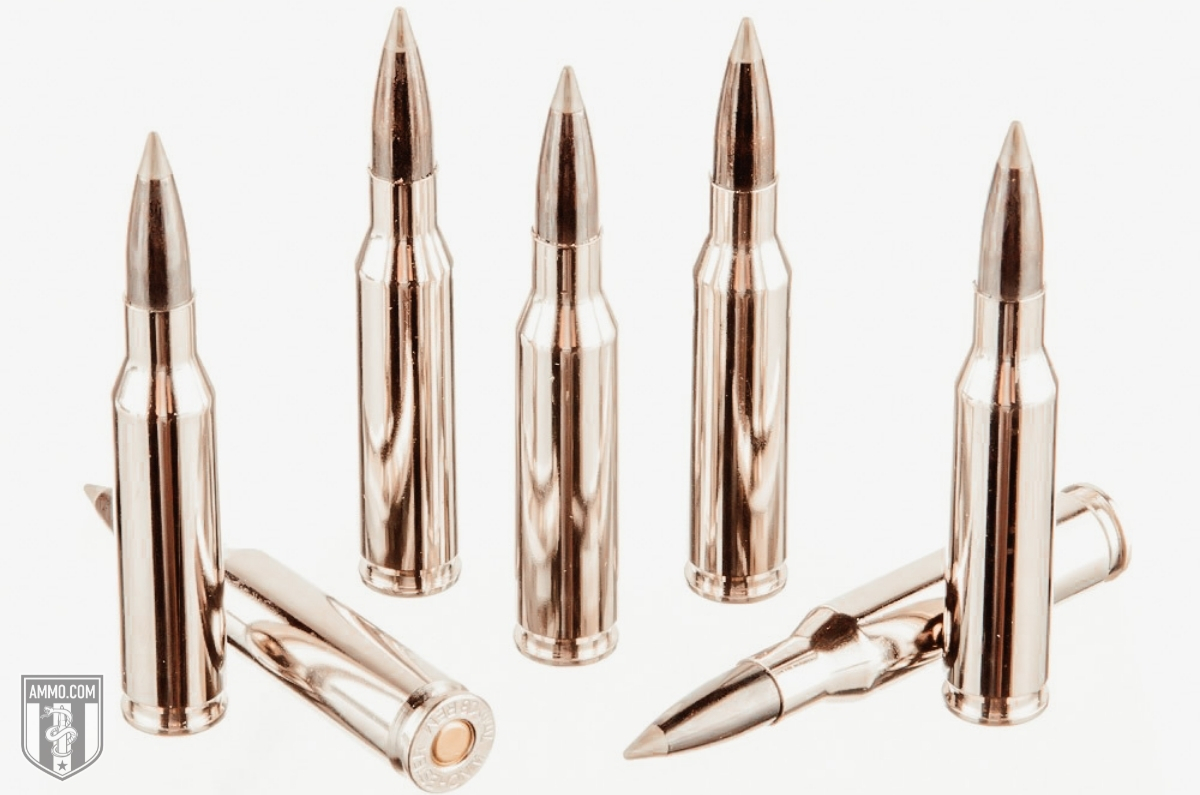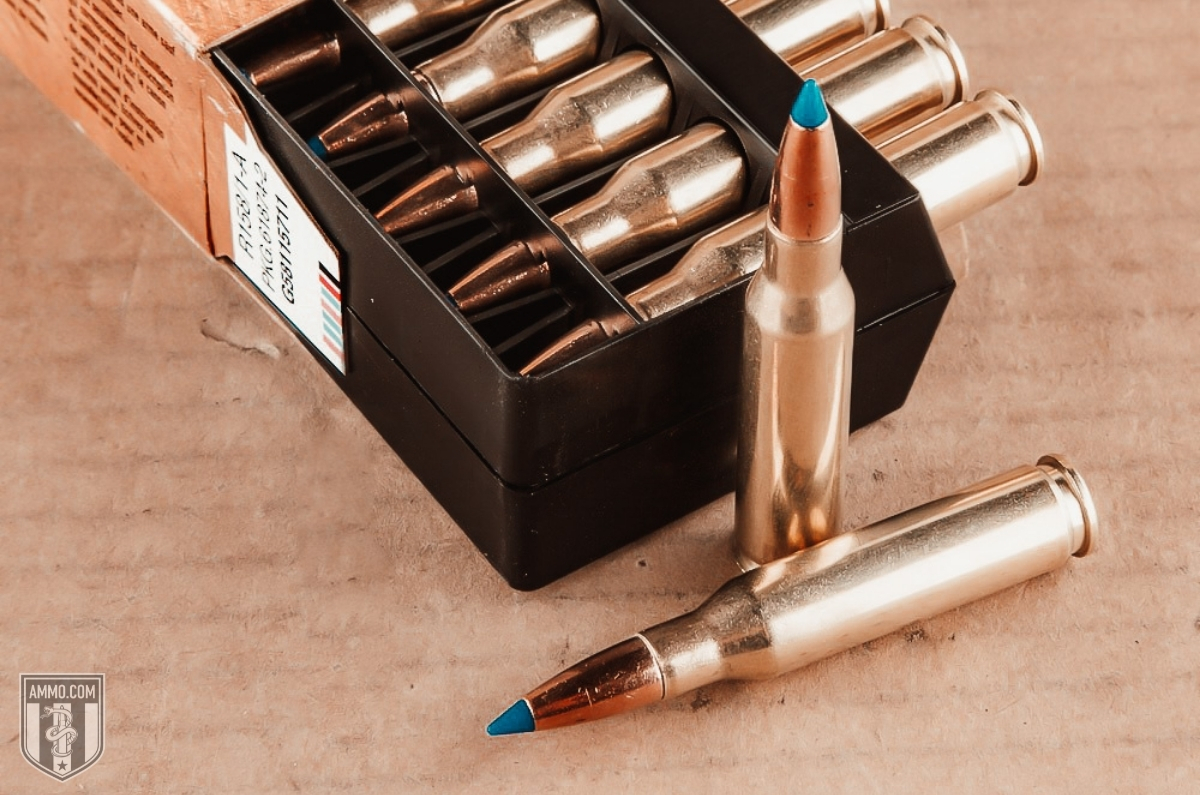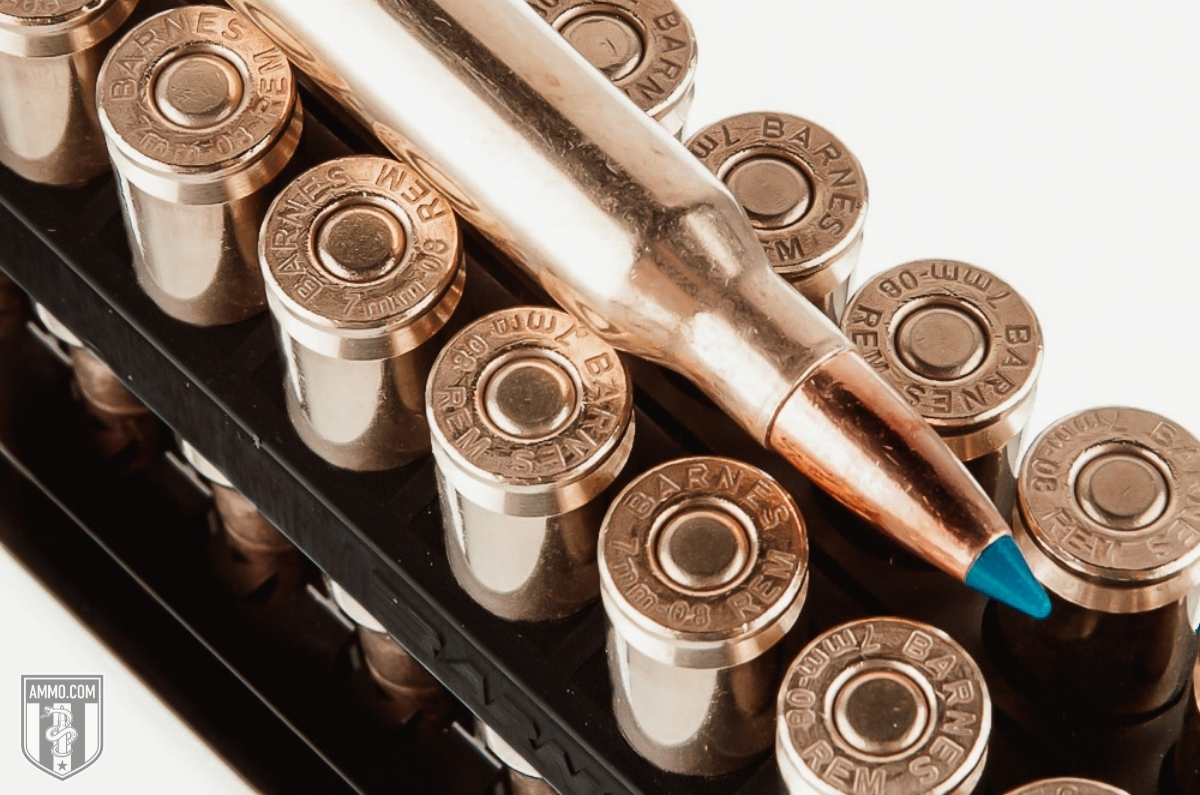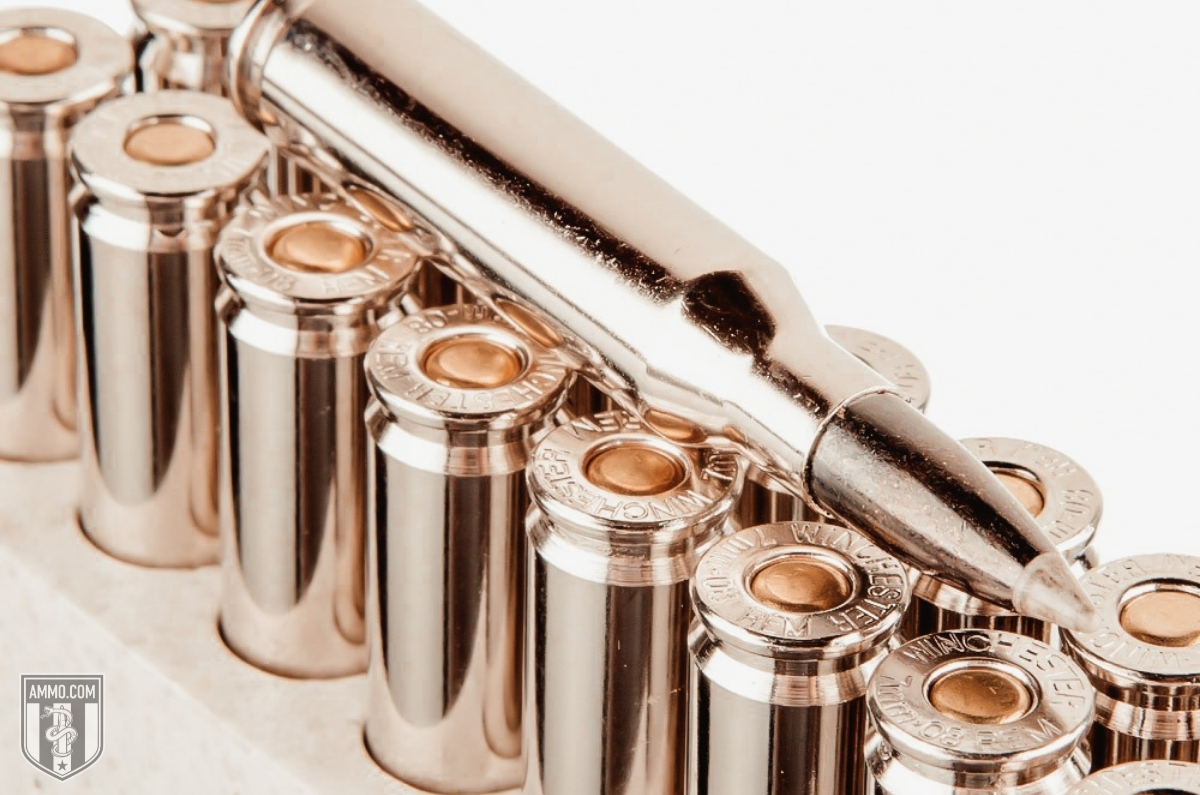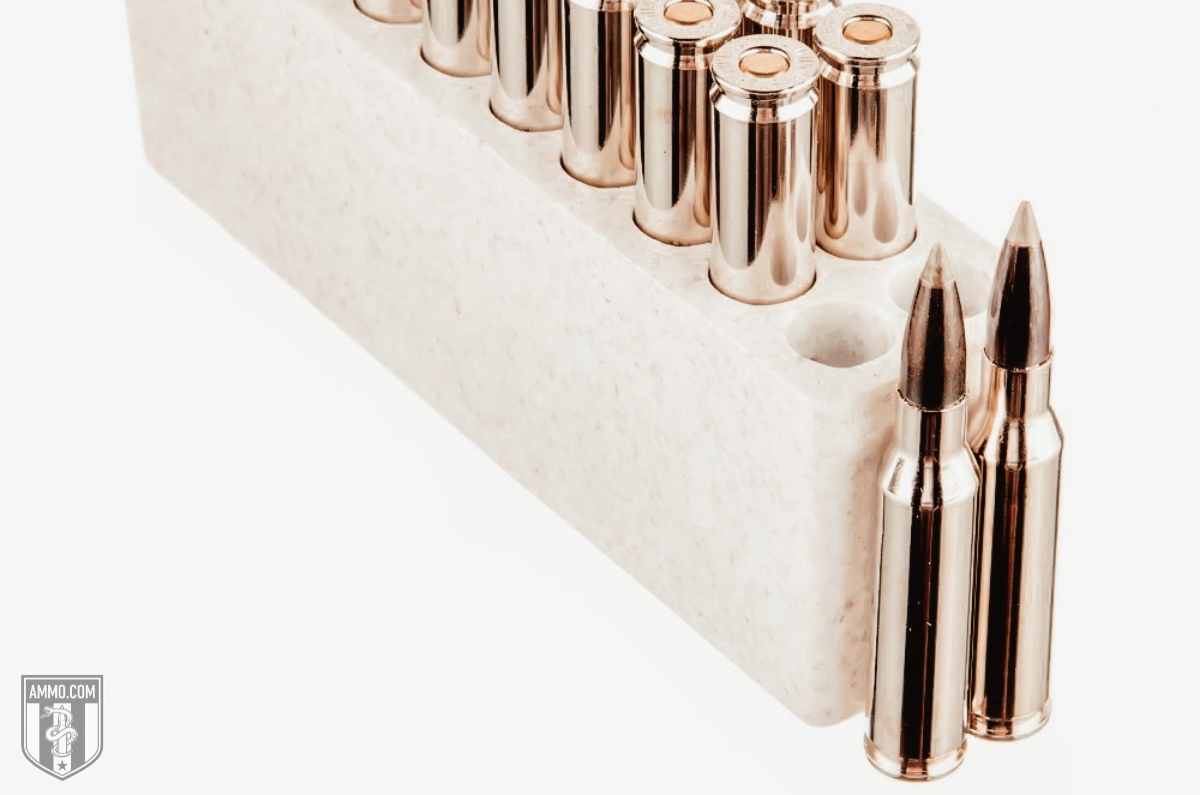7mm-08 vs .308: A Long Range Shootout
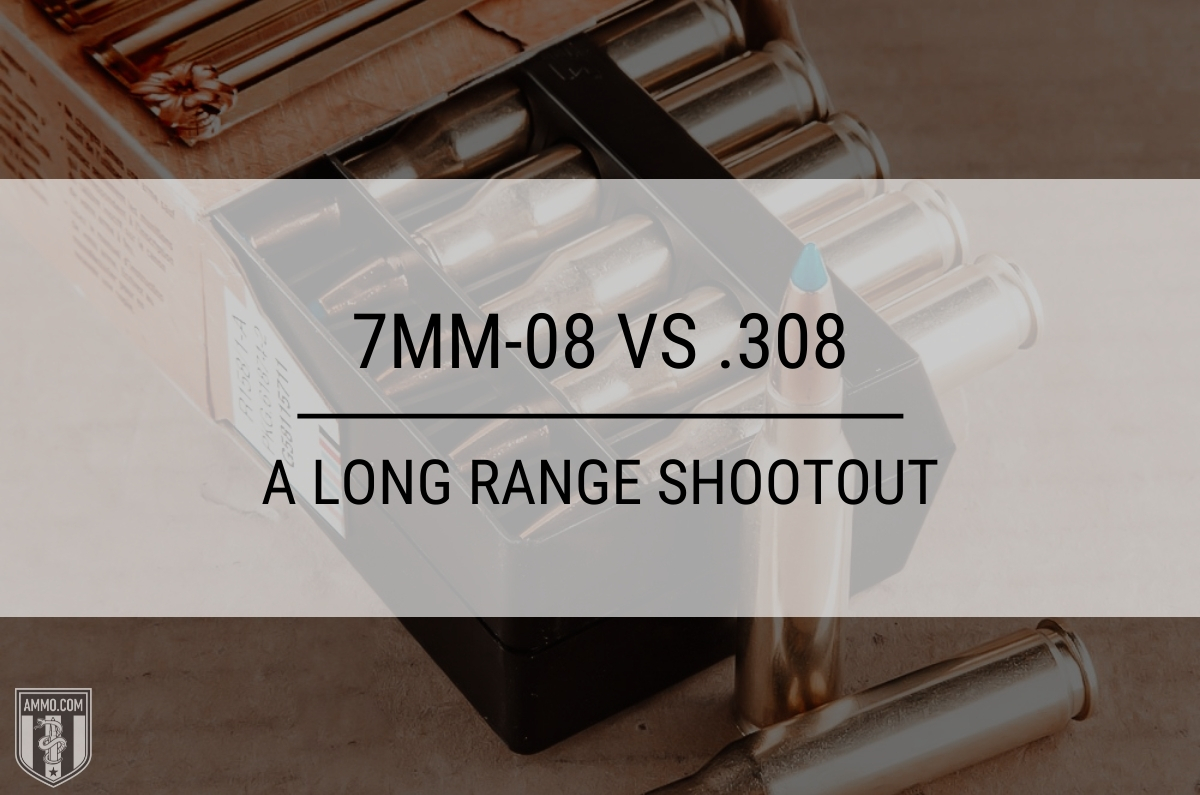 If you are looking for a great cartridge for your next hunting rifle, then you need not look further than the 308 Winchester and the 7mm-08 Remington. One was forged for battle, and the other was designed with long range shooting in mind.
If you are looking for a great cartridge for your next hunting rifle, then you need not look further than the 308 Winchester and the 7mm-08 Remington. One was forged for battle, and the other was designed with long range shooting in mind.
Is one cartridge superior to the other? When it comes to this caliber comparison, we are essentially splitting hairs between these two rifle cartridges.
However, the 7mm-08 Remington and the 308 Winchester are both potent hunting and long-range shooting cartridges and we will take a look at the history, ballistics, and defining characteristics of both.
Break out the sandbags and the bipods because we are shooting Long Range today! Let’s lock and load!
What is .308?
The Military Powerhouse
Following the Korean War, the U.S. Military was looking to upgrade their main battle rifle to keep pace with the Russian AK-47. They determined that they needed a select-fire battle rifle that could accept detachable magazines.
Although the 30-06 Springfield (7.62x63mm NATO or M2 Ball) had served America and its allies with distinction through two World Wars and Korea, it was clear that a short action cartridge was needed for reliable fully automatic fire.
Therefore, in the 1950s, the development of a new cartridge began with the objective to closely replicate the ballistics of the venerable 30-06 Springfield in a short action cartridge.
What came from this task force was the 7.62x51mm NATO that was accepted along with the M14 in 1958.
The Winchester corporation, which was part of the development of the 7.62x51 NATO, quickly saw its civilian application and adapted the round to its Model 70 bolt action rifle line. They renamed the cartridge the 308 Winchester and it quickly became hunting ammo of choice for whitetail enthusiasts and other big game hunters.
However, the success of the 308 Winchester did not end there!
Competitive marksmen quickly discovered that the 308 was an extremely accurate cartridge and the 308 Winchester quickly started dominating long range shooting competitions. So much so that the NRA had to shrink the bullseye on their high-power rifle targets to avoid ties between 308 shooters.
Although the 308’s life as the U.S. Military’s service rifle cartridge was rather short, being replaced by the 5.56x45mm NATO (223 Remington), it is still utilized by designated marksmen and snipers for its supreme accuracy and stopping power.
The proliferation of the 308 is beginning to decline with the rise of the 6.5 Creedmoor and the 300 Win Mag. That being said, there are still teams of military and police sharpshooters that utilize the tried-and-true cartridge in the line of duty to this day.
What is 7mm-08?
A Wildcatter’s Dream Come True
Do you know what happens when a new cartridge comes to market and becomes wildly popular? The wildcatters get to work.
It might be relevant to explain what a wildcatter is before we continue. A wildcatter is a handloader that likes to take existing cartridges and modifies them to shoot a different bullet. You can see another example of this when you examine .243 vs .308.
With the widespread success of the 308 Win, wildcatters had a new cartridge to work and make new and exciting ammo to meet their specific needs.
The 7mm-08 is simply a necked down 308 Winchester to accept a 7mm bullet. For many years, this wildcat cartridge was referred to as the 7mm/308.
In the 1980s, Remington decided that there was enough of a market to introduce a formal offering for the 7mm/308, and voila! The 7mm-08 Remington was born.
Remington has always had a bit of a soft spot for adopting wildcat cartridges and making them mainstream. Think along the lines of .35 Whelen, .25-06 Remington, .22-250 Rem, and the .257 Roberts, just to name a few.
The 7mm-08 offered several advantages over the 308 Winchester (which we will cover in a minute), but what it is more well known for is that it is a modern adaptation of the famed 7mm Mauser (7x57mm) round.
The 7mm Mauser cartridge was one of the first rimless, smokeless rifle cartridges of its era. Developed in 1892 by the German gunsmith and cartridge designer, Paul Mauser, the 7mm Mauser was the cartridge used as the basis for one of the greatest bolt action rifles of its time, the 1893 Mauser.
In 1893, the Spanish military and many other nations adopted the 7x57mm and the 1893 Mauser as their primary battle rifle. Referred to simply as the Spanish Mauser, the rifle saw extensive service in many conflicts in Europe, and more famously, the Spanish-American War.
During the conflict, the 1893 Mauser’s superior stripper clip loading design was showcased and eventually led to Springfield’s development of the 1903 Springfield, chambered in 30-06. The 7mm Mauser also saw extensive use in big game hunting. The British rebranded the 7x57mm to the 275 Rigby and it was used with extreme success by the Scottish big game hunter, W.D.M Bell.
Bell was the most prolific African big game hunter of his time, credited with harvesting over 1000 bull elephants for ivory (800+ of which he claimed with his 275 Rigby).
With its extensive military and hunting legacy, modern wildcatters have been trying to replicate the 7mm Mauser for years—this was accomplished in the 7mm-08 Remington.
The Comparison: 7mm-08 vs 308
Now that we are armed with a better understanding of where these two amazing rifle cartridges came from, let’s take a look at the specifics between each so you can make the best decision when you buy your new hunting rifle.
7mm-08 vs 308: Cartridge Specs
Let’s start off by taking a look at the differences between each cartridge case and their SAAMI Specifications.

As you can see, these two rifle cartridges are incredibly similar except for the bullet that they use.
Since the 7mm-08 parent case is the 308, they have almost identical dimensions. This means that they can both fit into a short action rifle.
This is important to note because it means that the primary differences between the 7mm-08 Rem and the 308 Winchester will be centered around the bullet that each cartridge fires.
7mm-08 vs 308: Recoil
In terms of recoil, it’s clear that the 7mm-08 is the winner in this category, but only by a small margin.
In general, the 308 Winchester will fire heavier bullets than the smaller 7mm-08 Remington. Bullet weight has a direct correlation to felt recoil and there’s no denying that the 7mm bullets fired from the 7mm-08 are low recoil.
On average, factory loads for 308 Winchester will have a felt recoil of around 22 ft-lbs of energy. Compare that to 17 ft-lbs of felt recoil for the 7mm-08 Rem.
That’s about 20% less recoil when comparing the 7mm-08 to the 308, and that is significant!
Shoulder wear is something that every shooter needs to consider when purchasing their new hunting rifle. Furthermore, talking about recoil is a “touchy” subject with some, suggesting that a low recoil caliber is somehow an affront to their manliness.
Rocky Balboa didn’t do us any favors when he said, “It’s not about how hard you hit, it’s about how hard you can get hit and keep moving forward!”
There are proponents in each camp proclaiming that you should either “man up” and take the recoil or just accept that the 7mm bullet is the better option and can do everything a 30-caliber bullet can do with less recoil.
And they’re both right and both wrong.
The correct answer is that it depends on the shooter.
If you’ve been trained on your dad’s 308 hunting rifle since you could first safely handle it, then lock and load that bad boy with some Hornady SST or Barnes TTSX and hit the woods for that trophy buck.
However, if you’re dealing with a smaller frame shooter or someone who is recoil sensitive, then I would not hesitate to start them off on a 7mm-08 as the softer recoil will help enforce proper shooting technique.
7mm-08 vs 308: Accuracy
Comparing the accuracy of two different cartridges is extremely difficult and often is more of a reflection of the person behind the rifle as opposed to the cartridge itself.
There are so many different variables that go into accuracy that it is nigh impossible to account for all of them.
As you’ll read in the next few sections, there is very little difference between the 7mm-08 Remington and the 308 Winchester from a ballistics standpoint.
Their muzzle velocity (fps), trajectory, ballistic coefficient, and sectional density are virtually identical between both cartridges (within a few percent).
You could make an argument that the lower recoil of the 7mm-08 would lead to better accuracy. However, as I mentioned earlier, this is more of a reflection on the shooter and not the cartridge itself.
Simply put, both the 308 Win and the 7mm-08 Rem are going to give you sub-MOA groups if you do your part.
7mm-08 vs 308: Trajectory
The trajectory is the measure of a bullet’s flight to the point of impact. As the old saying goes, “What goes up, must come down.” Gravity, as it seems, is inescapable even for bullets.
We measure trajectory in terms of bullet drop at specific distances.
You’ll often hear statements on Internet forums and idle chat at your local gun store along the lines of, “7mm Rem Mag has a really flat trajectory” or “6.5 Creedmoor shoots like a laser beam!”
Sadly, no bullet has a completely flat trajectory as all of them are pulled back to Earth eventually!
When we look at the Ballistic Tables below, we note that the 7mm-08 and the 308 have almost identical bullet drop at 400 yards when comparing bullets of similar weight. However, things start to open up when you get out into the longer range shots and the difference between the two cartridges is exacerbated.
That being said, even out to 700 yards, the 308 bullet has dropped approximately 138” and the 7mm-08 has dropped approximately 126”. That’s only 1-foot difference.
Now, you can make the argument that this could mean the difference between a hit and a miss, and you would be correct in this. However, it is rare that you would be shooting factory ammo at these extreme distances, and this is strictly in reload territory. Although there is a slight difference in trajectory at extreme range, the 7mm-08 and the 308 have very similar trajectories at almost all ranges.
7mm-08 vs 308: Ballistic Coefficient
Ballistic coefficient is a term that shooters either really pay attention to or avoid like the plague. To put it simply, ballistic coefficient (BC) is a mathematical representation of how aerodynamic a bullet is and how much it resists wind drift.
Typically, heavier bullets will have a higher BC. A higher BC means the bullet is more streamlined, can resist crosswinds more effectively, and are less susceptible to wind drift than bullets with a lower BC. Since the 308 Winchester can fire heavier bullets, logically you’d think that all 308’s have a higher BC. But in reality, this is not necessarily the case.
Let’s take the most common match grade bullet for the 308 Winchester, the 168 gr Sierra Gold Medal Match which has a BC of 0.45.
Now let’s compare that to the 7mm-08 Hornady Superformance SST 139gr bullet which has a higher BC of 0.486. In general, 308 bullets will have a slightly higher BC than their 7mm-08 counterparts, but again we are splitting hairs here. There are several 7mm-08 bullets that outperform the 308 and vice versa.
Bottom line: both the 308 Win and the 7mm-08 Rem have spectacular ballistic coefficients and will resist wind drift effectively.
7mm-08 vs 308: Sectional Density
Sectional Density is the measure of how well a bullet penetrates a target. This is extremely important for game hunters who need a bullet that can punch through thick hide, bone, and sinew.
Sectional density is calculated by comparing the bullet weight and the bullet diameter, the higher the number the more effective it will be at penetrating a target. What’s interesting when you compare these two calibers is that there are certain points of intersection when it comes to sectional density.
For example, a 140 gr 7mm-08 Winchester Ballistic Silvertip has the exact same sectional density as a 165gr 308 Nosler Ballistic Tip at 0.248. How is this possible? Logically it doesn’t make sense.
Well, it’s because of physics…and now I just lost you, I can feel your eyes glazing over through the computer.
Without getting into complex equations that would induce you into a mathematic coma, the 7mm-08 design allows it to exert higher pressure on a smaller surface area. This allows it to penetrate as deep as a heavier grain weight 308.
Obviously, this is a big selling point for the 7mm-08 – similar penetration with less recoil and a lighter bullet.
7mm-08 vs 308: Hunting
Now we come to the topic that ties all this ballistic performance data together – Hunting! All the calculations in the world cannot compare to real world data on how each round performs against varmints, medium, and large game animals.
The 308 has been the gold standard when it comes to hunting since its release in 1952. You can find about any type of rifle you want in 308, factory ammo for days that’s loaded specifically to the hunting target of your choice, and reload data for days if you want to tailor your own rounds. 308 Winchester has been a staple in deer hunting camps across North America for just short of 70 years, and that’s quite an accomplishment, to say the least.
30 caliber bullets are well known for their lethality and the 308’s ability to shoot heavier bullets makes it a great choice for larger game like elk, caribou, and even potentially black bears. Typically, you will find the most popular factory ammo for 308 Win loaded with a bullet weight between 150, 165, and 180 grains, with 200-grain bullets at the absolute top end.
If you walk into any sporting goods store across North America, you will find a plethora (read: dozens to hundreds) of options when it comes to 308 loadings. This is not quite true for the 7mm-08.
For 7mm-08 Rem, your choices in factory ammo are a bit more limited. Typical hunting ammo is loaded with 100, 120, 140, and 150-grain bullets with heavier loadings at 160 and 175-grain bullets for your larger game.
But which is going to be “better” when it comes to hunting? It depends on what your intended game animal is.
If you are looking to some varmint hunting and are taking aim at prairie dogs, groundhogs, or coyotes, I’d lean more towards the 7mm-08 in this case.
Its low recoil and lighter grain weight bullet options make it an ideal choice for this application. In truth, a 308 is a bit too much bullet for small game. You can definitely use it, but it feels a bit like overkill to me (unless you enjoy that sort of thing, then you might want to try a 325 WSM on a groundhog!)
The overlap between these two rifle cartridges comes when we enter the realm of deer hunting. Both of these cartridges will be exceptional when it comes to harvesting whitetail, mule deer, or pronghorn.
You can easily find ballistic tip or soft point ammo from all the major manufacturers like Hornady, Barnes, Sierra, Nosler, Remington, and Winchester.
For whitetail sized game, we’d recommend using a Nosler Accubond or Ballistic Tip, the Hornady SST, or the Barnes TTSX. All of which you can find for 30 caliber and 7mm bullets.
But is either ammo type better at harvesting deer? I’d say it’s a dead heat and a winner cannot be called, it all comes down to which cartridge you prefer or what rifle you own or are most comfortable with.
Now let’s discuss larger game, like elk and bears.
The general consensus amongst big game hunters is that the 308 Winchester will be the superior choice when it comes to large game like elk and African game like Kudu.
For the most part, I do agree that the terminal ballistics of the 30 caliber is going to be more well suited for taking larger game.
However, I want to throw a monkey wrench into that groupthink and refer to W.D.M Bell. Remember him from earlier? The Scottish hunter who harvested around 800 bull elephants with his 275 Rigby (7mm-08 equivalent).
This tells me one important thing when it comes to big game hunting: Shot Placement Trumps Caliber Selection.
Now does that mean that I’m going to recommend 7mm-08 for very large or dangerous game? No, I think utilizing something like a 375 H&H Magnum or a .416 Weatherby Magnum would be a better choice for those critters.
The added penetration and kinetic energy that these cartridges offer make them the superior choice for ethically harvesting the great bears, Cape Buffalo, and even elephants. But it also doesn’t mean you can’t get the job done with a 7mm-08 either.
It all comes down to marksmanship and proper shot placement when you have that trophy game animal in your sights. The real question you need to ask yourself with is this: “Which rifle cartridge do I shoot better?”
Answer that question and you’ll know which rifle to take on your next hunt.
7mm-08 vs 308: Ammo Price and Availability
When it comes to picking your new hunting rifle, ammo availability and price is always something that you need to consider.
As 308 Winchester is a U.S. military caliber and a NATO caliber, there are literally hundreds of different options when it comes to factory loads. This is not the case when it comes to the 7mm-08 as it is a newcomer on the scene for the most part.
For hunting ammo, there are plenty of options for both calibers and they are also priced about the same for both the 7mm-08 vs the 308.
However, the 308 has the advantage in ammo availability when it comes to cheaper practice ammo. You can easily find 308 practice ammo here on Ammo.com for under $1/round.
Buying in bulk is always smart, make sure to check out our stock of bulk 308 ammo.
Good luck finding 7mm-08 ammo ANYWHERE for under $1.50/round! (price quotes are accurate at the time of publishing)
7mm-08 vs 308: Rifle Availability
This is another category where 308 has the advantage over the 7mm-08. As the 308 has been around for about 40 more years than the 7mm-08, manufacturers have considerably more options when it comes to 308 chambered rifles.
Furthermore, many military surplus rifles are available in 308 Winchester as it is a NATO cartridge. You can even find an old Mauser that’s been converted to fire 308 if you’re willing to look a little.
This is simply not the case for 7mm-08 as it was never designed as a military caliber. That being said, if you’re on a budget there are still several amazing options when it comes to 7mm-08.
You can easily pick up a Savage Axis or a Ruger American chambered in 7mm-08 for under $500 at the time of publishing this article.
7mm-08 seems to be catching on and I can only imagine that more offerings in 7mm-08 will be available as the caliber grows in popularity.
7mm-08 vs 308: Reloading
If you like to handload as I do, then component availability is something to consider. Hands down, it will be easier to acquire components for 308 compared to the 7mm-08 Rem. Brass is cheap and plentiful, dozens of powders can be tried, and a wide variety of 30 caliber bullet options are available.
You can easily pick up a bag of 500 or more 308 brass casings from your local range or gun show with little effort, every reloading vendor will have them.
7mm-08 is a bit more difficult to come by in terms of acquiring brass as most people who shoot it are likely going to reload it as well. This limits you to purchasing new brass for your 7mm-08 or reusing factory loaded brass, which is fine but it does add a little more cost.
Reload data is also a bit more plentiful for 308 as it has been around longer and reloaders have experimented with it more.
However, both rifle cartridges are a breeze to hand reload and you should not shy away from reloading 7mm-08, just understand that you’ll definitely want to save your brass and that it’s unlikely you’ll find any lying around at your local gun range.
7mm-08 vs 308: Ballistics Tables
Our team here at Ammo.com has done an amazing job compiling tons of ballistic data from a myriad of factory loadings for both 308 and 7mm-08.
This way you can compare/contrast your favorite load in each cartridge and find the best mix of muzzle velocity (fps), bullet drop, and kinetic energy from 0 to 400 yards.
308 Ballistics
Note: This information comes from the manufacturer and is for informational purposes only. The actual ballistics obtained with your firearm can vary considerably from the advertised ballistics. Also, ballistics can vary from lot to lot with the same brand and type load.
| 308 Winchester Bullet WEIGHT | Muzzle VELOCITY (fps) | Muzzle ENERGY (ft. lbs.) | TRAJECTORY (in.) | |||||||||||
|---|---|---|---|---|---|---|---|---|---|---|---|---|---|---|
| Muzzle | 100 yds. | 200 yds. | 300 yds. | 400 yds. | Muzzle | 100 yds. | 200 yds. | 300 yds. | 400 yds. | 100 yds. | 200 yds. | 300 yds. | 400 yds. | |
| 55 Grain | 3770 | 3215 | 2726 | 2286 | 1888 | 1735 | 1262 | 907 | 638 | 435 | -2 | 1.4 | -3.8 | -15.8 |
| 110 Grain | 3165 | 2830 | 2520 | 2230 | 1960 | 2447 | 1956 | 1551 | 1215 | 938 | 1.4 | 0 | -6.9 | -20.9 |
| 120 Grain | 2850 | 2497 | 2171 | n/a | n/a | 2164 | 1662 | 1256 | n/a | n/a | 0 | -2.8 | n/a | n/a |
| 150 Grain | 2820 | 2533 | 2263 | 2009 | 1774 | 2648 | 2137 | 1705 | 1344 | 1048 | 2.5 | 0.4 | -8.5 | -26.1 |
| 150 Grain Superformance | 3000 | 2772 | 2555 | 2348 | 1962 | 2997 | 2558 | 2173 | 1836 | 1540 | 1.5 | 0 | -6.9 | -20 |
| 155 Grain | 2775 | 2553 | 2342 | 2141 | 1950 | 2650 | 2243 | 1887 | 1577 | 1308 | 1.9 | 0 | -8.3 | -24.2 |
| 155 Grain | 2850 | 2640 | 2438 | 2247 | 2064 | 2795 | 2398 | 2047 | 1737 | 1466 | 1.8 | 0 | -7.5 | -22.1 |
| 165 Grain | 2700 | 2440 | 2194 | 1963 | 1748 | 2670 | 2180 | 1763 | 1411 | 1199 | 2.5 | 0 | -9.7 | -28.5 |
| 168 Grain | 2680 | 2493 | 2314 | 2143 | 1979 | 2678 | 2318 | 1998 | 1713 | 1460 | 2.5 | 0 | -8.9 | -25.3 |
| 168 Grain Super Match | 2870 | 2647 | 2462 | 2284 | 2114 | 3008 | 2613 | 2261 | 1946 | 1667 | 1.7 | 0 | -7.5 | -21.6 |
| 170 Grain | 2000 | 1740 | 1510 | n/a | n/a | 1510 | 1145 | 860 | n/a | n/a | 0 | 0 | 0 | 0 |
| 178 Grain | 2620 | 2415 | 2220 | 2034 | 1857 | 2713 | 2306 | 1948 | 1635 | 1363 | 2.5 | 0 | -9.6 | -27.6 |
| 178 Grain Super Match | 2780 | 2609 | 2444 | 2285 | 2132 | 3054 | 2690 | 2361 | 2064 | 1797 | 1.8 | 0 | -7.6 | -21.9 |
| 180 Grain | 2620 | 2393 | 2178 | 1974 | 1782 | 2743 | 2288 | 1896 | 1557 | 1269 | 2.5 | -0.2 | -10.2 | -28.5 |
7mm-08 Rem Ballistics
Note: This information comes from the manufacturer and is for informational purposes only. The actual ballistics obtained with your firearm can vary considerably from the advertised ballistics. Also, ballistics can vary from lot to lot with the same brand and type load.
| 7mm-08 Rem Bullet WEIGHT | Muzzle VELOCITY (fps) | Muzzle ENERGY (ft. lbs.) | TRAJECTORY (in.) | |||||||||||
|---|---|---|---|---|---|---|---|---|---|---|---|---|---|---|
| Muzzle | 100 yds. | 200 yds. | 300 yds. | 400 yds. | Muzzle | 100 yds. | 200 yds. | 300 yds. | 400 yds. | 100 yds. | 200 yds. | 300 yds. | 400 yds. | |
| 120 Grain | 2675 | 2435 | 2207 | 1992 | 1790 | 1907 | 1579 | 1298 | 1057 | 854 | 2.2 | 0 | -9.4 | -27.5 |
| 120 Grain | 3000 | 2725 | 2467 | 2223 | 1992 | 2398 | 1979 | 1621 | 1316 | 1058 | 2 | 0 | -7.6 | -22.3 |
| 139 Grain | 2840 | 2608 | 2387 | 2177 | 1978 | 2489 | 2098 | 1758 | 1463 | 1207 | 1.8 | 0 | -7.9 | -23.2 |
| 139 Grain Superformance | 2950 | 2857 | 2571 | 2393 | 2222 | 2686 | 2345 | 2040 | 1768 | 1524 | 1.5 | 0 | -6.8 | -19.7 |
| 140 Grain | 2860 | 2625 | 2402 | 2189 | 1988 | 2542 | 2142 | 1793 | 1490 | 1228 | 2.5 | 0.8 | -6.9 | -21.9 |
| 154 Grain | 2715 | 2510 | 2315 | 2128 | 1950 | 2520 | 2155 | 1832 | 1548 | 1300 | 2.5 | 1 | -7 | -22.7 |
7mm-08 vs 308: Conclusions
If you’re in the market for a great cartridge, look no further than the 308 Winchester and the 7mm-08. Both of these rifle cartridges will serve you well in the forests of North America to the plains of the Serengeti.
Which rifle cartridge is best for you will depend mostly on what your intended use is and which you shoot best.
If you’ve trained on 308 Winchester for years and you are looking to hunt big game like elk and caribou, then grab some ballistic tips and head into the woods to claim that trophy whitetail.
Or if you want something that has a bit less recoil, shoots a little flatter, and has a similar ballistic performance to 30 caliber, then you might be in the market for a 7mm-08.
Regardless of which you choose, both will get the job done at a longer range so long as you do your part.
Get out to the range and practice with your favorite, you won’t be disappointed with either of these amazing big game hunting options.
Ammo Comparisons
- .308 vs 5.56
- 6.5 Creedmoor vs .308
- .300 Blackout vs .308
- .300 Win Mag vs .308
- .243 vs .308
- .308 vs .30-06
- 7mm-08 vs .308
- .270 vs .308
- 7.62x39 vs .308
- .223 vs .308
- .338 Lapua vs .308
- .380 ACP vs 9mm
- .223 vs 5.56
- .300 Blackout vs 5.56
- 9mm vs 45 ACP
- 9mm vs 40 S&W
- .357 SIG vs 9mm
- 10mm vs 9mm
- 9mm vs 9mm Luger
- .243 vs .270
- .300 Win Mag vs .30-06
- .270 vs .30-06
- .40 vs .45
- 38 Special vs 357
- 9mm vs 40 vs 45
- 5.56 vs 7.62x39
- 338 Lapua vs .30-06
- .30-30 vs .30-06
- 300 PRC vs 338 Lapua
- .30-06 vs 7mm
- 300 Win Mag vs 338 Lapua
- 300 PRC vs 300 Win Mag
- 300 WSM vs 300 Win Mag
- 338 Win Mag vs 338 Lapua
- 12 Gauge vs 20 Gauge
- 10mm vs 357 Mag
- .30-30 vs 7.62x39
- 224 Valkyrie vs 22-250
- 17 HMR vs 22 Mag
- 7.62x39 vs .300 Blackout
- 45 ACP vs 45 Auto
- 45-70 vs 30-30
- 300 Blackout vs 223
- 357 Magnum vs 9mm
- 350 Legend vs 300 Blackout
- 224 Valkyrie vs 223
- 45 ACP vs 38 Super
- 6.5 Grendel vs .308
- 17 HMR vs 22 LR
- 10 Gauge vs 12 Gauge
- 22-250 vs 223
- 45 Colt vs 45 ACP
- 350 Legend vs 30-30
- 5.7x28 vs 223
- 5.7 vs 9mm
- 5.56 vs 5.7
- 22 vs 9mm
- Buckshot vs Birdshot
- 450 Bushmaster vs 308
- 450 Bushmaster vs 223
- Buckshot vs Slug
- 6.5 Grendel vs 5.56 vs 223
- 6mm ARC vs 6.5 Grendel
- 44 vs 45
- 458 SOCOM vs 5.56
- 357 vs 44
- 32 ACP vs 380
- 300 Win Mag vs 338 Win Mag vs 338 Lapua Mag
- 450 Bushmaster vs 458 SOCOM vs 50 Beowulf
- 6mm Creedmoor vs 6.5 Creedmoor
- TMJ vs FMJ
- 44 Special Vs 44 Magnum
- 45 90 vs 45 70
- 6.8 Western vs 6.8 SPC
- 50 Beowulf vs 50 BMG
- 26 Nosler vs 6.5 PRC
- 28 Gauge vs 410
- 6.8 SPC vs 5.56
- 6.8 SPC vs 6.5 Grendel
- 6.8 Western vs 7mm Rem Mag vs .28 Nosler
- 6.8 Western vs 6.5 Creedmoor
- 22 Hornet vs 223
- 6.8 Western vs 6.5 PRC
- .410 vs 12 Gauge
- .410 vs 20 Gauge
- 22 LR vs 22 Mag
- 6mm ARC vs 243
- 7mm-08 vs 270
- 243 vs 6.5 Creedmoor
- Nickel vs Brass Casing
- 204 Ruger vs 223
- 50 Beowulf vs 5.56
- 260 Remington vs 6.5 Creedmoor
- 6mm Remington vs 243
- 28 Nosler vs 300 PRC
- 50 Beowulf vs 50 AE
- 22 Nosler vs 22-250
- 450 Marlin vs 45-70
- 300 Win Mag vs 300 Norma
- 458 SOCOM vs 300 Blackout
- 38-55 vs 45-70
- 22 Hornet vs 22 LR
- 300 Norma vs 338 Lapua
- 338 Lapua vs 50 BMG
- 28 Nosler vs 300 Win Mag
- 28 Nosler vs 6.5 Creedmoor
- 204 vs 22-250
- 458 SOCOM vs 45 70
- 44 40 vs 45 70
- 6.8 SPC vs 6.5 Creedmoor
- 450 Bushmaster vs 30-06
- 7mm Rem Mag vs 300 Win Mag
- 30 Carbine vs 223
- 25-06 vs 30-06
- 26 Nosler vs 28 Nosler
- 16ga vs 12ga
- 30 06 vs 7.62 x54R
- 9mm Makarov vs 9mm Luger
- 350 Legend vs 223
- 30 Carbine vs 5.56
- 6.5x55 vs 6.5 Creedmoor
- 6.5 Creedmoor vs 270 vs 25-06
- M193 vs M855
- 450 Bushmaster vs 458 SOCOM
- 6.5 Grendel vs 6.5 Creedmoor
- 350 Legend vs 5.56
- .277 Fury vs 6.8 SPC
- 277 Fury vs 300 Win Mag
- 10mm vs .45 ACP
- 277 Fury vs 223
- 6.8 SPC vs 300 Blackout
- 6.5 PRC vs 6.5 Creedmoor
- 277 Fury vs 308
- 277 Fury vs 6.5 Creedmoor
- 350 Legend vs 450 Bushmaster
- 277 Fury Vs 5.56 NATO
- 10mm vs 40S&W
- 32 ACP vs 9mm
- 32 Special vs 9mm
- 8.6 Blackout vs 300 Blackout
- 30 Super Carry vs. 9mm
- 5.56 vs 9mm
- .50 Action Express vs 9mm
- 7.62x25 vs. 9mm
- 10mm vs 44 Magnum
- 300 Blackout vs 300 Win Mag
- 6.5 Grendel vs 300 Blackout
- 460 Rowland vs 10mm
- 300 RUM vs 300 PRC
- 300 Norma vs 300 PRC
- 45 GAP vs 45 ACP
- 7mm PRC vs 300 Win Mag
- 300 PRC vs 6.5 Creedmoor
- 300 PRC vs 308
- 357 SIG vs 357 Mag
- 7.62x39 vs 7.62x51
- 243 Win vs 223 Rem
- 30 Nosler vs 300 PRC
- 6.5 Creedmoor vs. 30-06 Springfield
- 450 S&W vs. 44 Magnum
- 6.5 Creedmoor vs. 300 Win Mag
- 454 Cassull vs. 45-70 Govt
- 454 Cassull vs. 44 Mag
- 7.62x54r vs. 308 Winchester
- 22 ARC vs. 223 Rem
- Subsonic vs. Supersonic Ammo
